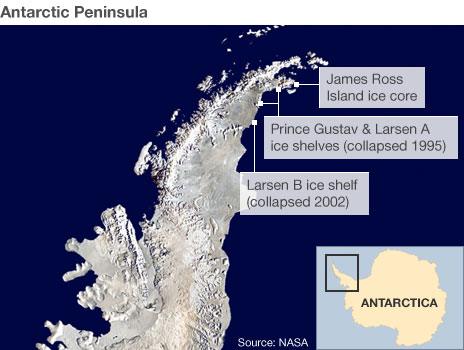Antarctica warmth 'unusual, but not unique'
- Published

The northern end of the Antarctic Peninsula is warming fast
The recent Antarctic Peninsula temperature rise and associated ice loss is unusual but not unprecedented, according to research.
Analysis of a 364m-long ice core containing several millennia of climate history shows the region previously basked in temperatures slightly higher than today.
However, the peninsula is now warming rapidly, threatening previously stable areas of ice, the study warns.
The work is reported in Nature journal, external.

Antarctic Peninsula ice shelves are under increasing threat, with several recent collapses
The Antarctic Peninsula, the rugged protrusion extending towards South America, is one of the most rapidly warming places on the planet.
Measurements taken since 1958 show that seasonal temperatures have increased by around 3C.
This has coincided with a marked increase in glacial activity and the collapse of several ice shelves, including Prince Gustav and Larsen A, external and B.
Ice shelves are floating extensions of the grounded ice covering the continent.
According to the British Antarctic Survey (BAS), external, ice equivalent to 1,000 years of British domestic water consumption has been lost over the past half century.
Cores and effect
To determine whether this modern warming is extraordinary, BAS researchers drilled and analysed an ice core from James Ross Island (JRI). The site was chosen because of its proximity to recent ice shelf collapses.
An ice core - formed by compaction of previous snowfalls - constitutes a historical record of the local climate and atmosphere stretching back over thousands of years.

The drill site was chosen because of its proximity to recent ice shelf collapses
The JRI ice core, taken in the Antarctic summer of 2008, contained in total about 50,000 years of climate history.
Entombed within the ice core were quantities of a tell-tale type, or isotope, of hydrogen called deuterium.
Atoms of deuterium contain a neutron, whereas "normal" hydrogen atoms do not.
By measuring the ratio of "normal" hydrogen to the heavier deuterium, Dr Robert Mulvaney, external and his team were able to make a detailed reconstruction of temperatures spanning the last 15,000 years.
The analysis revealed that 15,000-12,000 years ago, the Antarctic Peninsula experienced significant warming, becoming about 1C warmer than today.
The region then cooled markedly around 2,500 years ago, and temperatures remained relatively stable. This co-incided with the late-Holocene development of ice shelves near JRI.
Around 600 years ago, the peninsula started to warm once more - slowly at first, but then, from around 1920, much more rapidly.
Human origins?
Changes in the Earth's orbit and tilt produce natural fluctuations in climate.

Locked away in the ice core is a historical record of Antarctic temperatures
Average temperatures change slowly - at a rate of roughly 0.1-0.2C per century.
But the research showed that the recent rate of change in the peninsula has been considerably faster.
Prof Eric Steig, external from the University of Washington in Seattle has reported similar changes in West Antarctica.
Commenting on the likely cause, Prof Steig told BBC News: "A fingerprint of forced climate change - that is, anthropogenic (man-made) forcing of climate by greenhouse gases - is that it will warm in most places at the same time.
"And that's clearly the fingerprint that we are seeing."
This is a view shared by Prof Peter Nienow, external, a glaciologist at the University of Edinburgh, who said: "The significant warming being seen in many places across the planet makes it unlikely that the recent warming reported in this paper is due just to local natural variability."
In his Nature paper, Dr Mulvaney did not conclude that the recent changes observed in the peninsula were down to human activity.
However, when asked about this, he said: "If I am pressed to say whether I think it's human-induced, then I would say what we are seeing is human-induced."
- Published25 April 2012
- Published25 July 2012
- Published16 February 2012
- Published23 July 2012
- Published21 August 2012